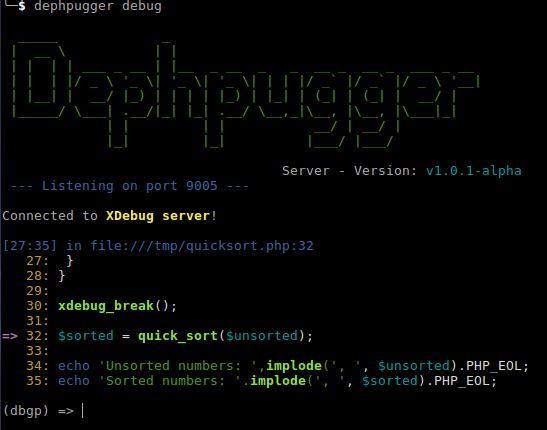Commands to Run
Commands
When the debugger stop in a breakpoint, it wait the developer send commands to navigate in code.
Create a file called quicksort.php (or with another algorithm). We will use this file for example.
<?php
$unsorted = array(43,21,2,1,9,24,2,99,23,8,7,114,92,5);
function quick_sort($array)
{
$length = count($array);
if($length <= 1){
return $array;
} else {
$pivot = $array[0];
$left = $right = array();
for($i = 1; $i < count($array); $i++)
{
if($array[$i] < $pivot){
$left[] = $array[$i];
} else {
$right[] = $array[$i];
}
}
return array_merge(quick_sort($left), array($pivot), quick_sort($right));
}
}
xdebug_break();
$sorted = quick_sort($unsorted);
echo 'Unsorted numbers: ',implode(', ', $unsorted).PHP_EOL;
echo 'Sorted numbers: '.implode(', ', $sorted).PHP_EOL;
Run in different terminals.
$ dephpugger debug # in first terminal
$ dephpugger cli quicksort.php # in another terminal

The debugger is waiting you to run a command. If you run the command help, you will see all possible commands.
| Command | Alias | Explanation |
|---|---|---|
| next | n | To run a step over in code |
| step | s | To run a step into in code |
| set <cmd>:<value> | Change verboseMode or lineOffset in runtime | |
| continue | c | To continue script until found another breakpoint or finish the code |
| list | l | Show next lines in script |
| list-previous | lp | Show previous lines in script |
| help | h | Show help instructions |
| $variable | Get a value from a variable | |
| $variable = 33 | Set a variable | |
| my_function() | Call a function | |
| dbgp(< command >) | To run a command in dbgp | |
| quit | q | Exit the debugger |
Now you can navigate in the algorithm and investigate.
Press n to go to the next line, if exists.
Press s and press enter to get inside the method.
Press l to see the next lines.
Press lp to see the previous lines.
Key the variable name to get the value and type.
You can change the variable value in runtime.